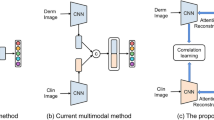Abstract
The mortality of skin pigmented malignant lesions is very high, especially melanoma. Due to the limitation of marking means, the large-scale annotation data of skin lesions are generally more difficult to obtain. When the deep learning model is trained on a small dataset, its generalization performance is limited. Using prior knowledge to expand small sample data is a general model method of learning classification, which is difficult to deal with complex skin problems. On the basis of a small amount of labeled skin lesion image data, this paper uses the improved Relational Network for measurement learning to realize the classification of skin disease. This method uses relative position network (RPN) and relative mapping network (RMN), in which RPN captures and extracts feature information by attention mechanism, and RMN obtains the similarity of image classification by weighted sum of attention mapping distance. The average accuracy of classification is 85% on the public ISIC melanoma dataset, and the results show the effectiveness and applicability of the method.






Similar content being viewed by others
References
Bertinetto L, Henriques JF, Torr PHS et al. (2018) Meta-learning with differentiable closed-form solvers. arXiv preprint arXiv:1805.08136
Codella N, Rotemberg V, Tschandl P, et al. Skin lesion analysis toward melanoma detection 2018: A Challenge Hosted by the International Skin Imaging Collaboration (ISIC). 2019
Dulmage B, Tegtmeyer K, Zhang MZ et al (2021) A point-of-care, real-time artificial intelligence system to support clinician diagnosis of a wide range of skin diseases. J Invest Dermatol 140(5):1230–1235
Esteva A, Kuprel B, Novoa RA et al (2017) Dermatologist-level classification of skin cancer with deep neural networks. Nature 542:115–118
Fan Y, Rui X, Poslad S et al (2020) A better way to monitor haze through image based upon the adjusted LeNet-5 CNN model. Signal Image Video Process 14(2):455–463
Hyperspectral Image with limited labeled samples (2018). Signal Process, 145
Jeddi FR, Arabfard M, Arabkermany Z et al (2016) The diagnostic value of skin disease diagnosis expert system. Acta Inform Med 24(1):30–33
Kawahara J, Bentaieb A, Hamarneh G (2016) Deep features to classify skin lesions. IEEE International Symposium on Biomedical Imaging. IEEE
Leibe B, Matas J, Sebe N et al. (2016) A Benchmark for automatic visual classification of clinical skin disease images. In: European conference on computer vision. Springer, Cha,: pp 206–222
Liu X, Zhou F, Liu J et al (2020) Meta-learning based prototype-relation network for few-shot classification. Neurocomputing 383:1–4
Malla S, Alphonse PJA (2021) COVID-19 outbreak: an ensemble pre-trained deep learning model for detecting informative tweets. Appl Soft Comput J 2021(107):107495
Menegola A, Fornaciali M, Pires R et al. (2017) Knowledge transfer for melanoma screening with deep learning. In: IEEE International Symposium on Biomedical Imaging. IEEE, pp 297–300
Patrick PM, Reitsma JB, Bruns DE et al (2015) An updated list of essential items for reporting diagnostic accuracy studies. Clin Chem 2015:351
Snell J, Swersky K, Zemel R (2017) Prototypical networks for few-shot learning. Adv Neural Inform Process Syst 2:4077–4087
Sousa A, Prudêncio RBC, Ludermir TB et al (2016) Active learning and data manipulation techniques for generating training examples in meta-learning. Neurocomputing 194:45–55
Sung F, Yang Y, Zhang L, et al. (2017) Learning to compare: relation network for few-shot learning. In: Proceedings of the IEEE conference on computer vision and pattern recognition
Tschandl P, Rosendahl C, Kittler H (2018) The HAM10000 dataset: a large collection of multi-source dermatoscopic images of common pigmented skin lesions. Sci Data 5:180161
Valle E, Fornaciali M, Menegola A et al (2020) Data, depth, and design: learning reliable models for skin lesion analysis. Neurocomputing 383:303–313
Xu Z, Xu Z, Zhuang J et al (2020) Auxiliary decoder and classifier for imbalanced skin disease diagnosis. J Phys 1631(1):012146
Xu C, Shen J, Du X (2020) A method of few-shot network intrusion detection based on meta-learning framework. IEEE Trans Inform Forensics Secur 99:1–1
Xue Z, Xie Z, Xing Z, et al. (2020) Relative Position and map networks in few-shot learning for image classification. In: 2020 IEEE/CVF Conference on Computer Vision and Pattern Recognition Workshops (CVPRW). IEEE
Yosinski J, Clune J, Bengio Y et al (2014) How Transferable are features in deep neural networks? Adv Neural Inform Process Syst 2:3320–3328
Zhong Z, Wei F, Lin Z et al (2019) ADA-Tucker: compressing deep neural networks via adaptive dimension adjustment tucker decomposition. Neural Netw 110:104–115
Zhou Y, Hospedales TM et al (2016) When and where to transfer for bayesian network parameter learning. Expert Syst Appl 55:361–373
Zeiler MD, Fergus R (2014) Visualizing and understanding convolutional networks. European conference on computer vision. Springer, Cham, pp 818–833
Author information
Authors and Affiliations
Corresponding author
Additional information
Publisher’s note
Springer Nature remains neutral with regard to jurisdictional claims in published maps and institutional affiliations.
Rights and permissions
About this article
Cite this article
Liu, XJ., Li, Kl., Luan, Hy. et al. Few-shot learning for skin lesion image classification. Multimed Tools Appl 81, 4979–4990 (2022). https://doi.org/10.1007/s11042-021-11472-0
Received:
Revised:
Accepted:
Published:
Issue Date:
DOI: https://doi.org/10.1007/s11042-021-11472-0




